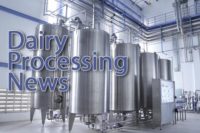For about the past 20 years, the food and beverage industry has used high-pressure processing (HPP) to improve the safety of products. Foods such as sliced meats, avocado dips and certain beverages have especially benefited from this technology. Could the dairy industry also profit?
For the most part, the dairy industry is in the early stages of experimenting with high-pressure technology such as HPP. Preliminary results indicate that HPP could provide benefits that include extending the shelf life of dairy products, using fewer preservatives or antimicrobial agents (clean label), and accelerating cheese ripening.
As the name implies, HPP systems apply and then release high amounts of hydrostatic pressure by the compression of a fluid medium, typically water. HPP systems generally utilize a conveyor belt that automatically feeds packaged products into a vessel where pressure is applied anywhere from 300-600 megapascal for three minutes (but up to 20 minutes) in a continuous or pulsed stage.
Since a risk of contamination typically occurs due to handling, HPP offers an advantage in that the products are typically in their final packaging when they go through the HPP system. The process of applying and releasing pressure induces physical, chemical and biochemical changes in microorganisms, including the inactivation of foodborne pathogens or spoilage organisms. HPP is also beneficial for those products that cannot handle the high heat of pasteurization due to the resulting textural or flavor changes that it causes.
High-pressure research
At the Center for Dairy Research, we’ve done research on utilizing HPP. One of our projects studied if HPP could extend the shelf life and functionality of low-moisture part-skim (LMPS) mozzarella.
Usually after more than two months of refrigeration, this cheese becomes soft and loses some of its functionality (melting, stretching or shredding), which is the main factor limiting its shelf life. By making changes to the cheesemaking procedure and using HPP, which can inactivate enzymes, we were able to produce LMPS mozzarella that still had good body and functionality after nine months of refrigerated storage.
However, we tried HPP with several other cheese types, and not all equally benefited from its use. So it will be a case-by-case basis of determining where and how the technology can help extend the shelf life of cheese.
We also need to be aware that there is a cost to run products through HPP systems. Therefore, dairy products with low profit margins are probably not good candidates, whereas products with higher profit margins are better suited to absorb the additional cost. These costs could well be worth it because by extending the shelf life of some cheeses, the U.S. dairy industry could increase its export market. Currently, only about 5-6% of U.S. cheese is exported.
We also discovered HPP’s ability to accelerate the ripening process of cheese. By using a lower pressure, we found that some cheeses that were only a month or so old could be made to taste like a six-month-old cheese.
We hypothesized that by applying pressure, we helped break down the initial curdy texture, as well as caused the bacteria in the cheese to become leaky and release the materials that help the cheese ripen. In addition to better flavor, the texture was also smoother and more cohesive.
I think it’s important that the dairy industry be aware of the encouraging results of high-pressure technology. Any new tool that can help us improve food safety, extend shelf life or accelerate cheese ripening is worth looking into. The challenge is identifying the specific products or cheeses that can benefit from this technology and then developing consistent methods to achieve the results we want in an economical fashion.




